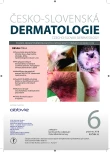Identification of Dermatophytes Using MALDI-TOF Mass Spectrometry
Authors:
R. Walková 1,2; H. Janouškovcová 1,2; M. Šnajdrová 1; V. Hubka 3,4; A. Čmoková 3,4; J. Hrabák 1,2
Authors‘ workplace:
Ústav mikrobiologie, Fakultní nemocnice Plzeň, přednosta RNDr. Karel Fajfrlík, Ph. D.
1; Laboratoř antibiotické rezistence a aplikací hmotnostní spektrometrie v mikrobiologii, Biomedicínské centrum, Lékařská fakulta v Plzni, Univerzita Karlova, Plzeň, vedoucí laboratoře Costas C. Papagiannitsis, Ph. D.
2; Katedra botaniky, Přírodovědecká fakulta, Univerzita Karlova, Praha, vedoucí katedry doc. RNDr. Yvonne Němcová, Ph. D.
3; Laboratoř genetiky a metabolismu hub, Mikrobiologický ústav, Akademie věd České republiky, v. v. i., Praha, vedoucí laboratoře Mgr. Miroslav Kolařík, Ph. D.
4
Published in:
Čes-slov Derm, 93, 2018, No. 6, p. 250-256
Category:
Clinical and laboratory Research
Overview
Dermatophytes are microscopic fungi causing skin infections and infections of skin adnexa. Their identification is usually performed by morphological characteristics requiring experienced microbiologists and quiet long turnaround time. In recent years, matrix-assisted laser desorption/ionization time-of-flight mass spectrometry (MALDI-TOF MS) has been introducing to many diagnostic laboratories allowing identification of dermatophytes as well. For that purpose, however, specific procedures comparing with bacteria and yeasts must be used because of their complex morphology and specific cultivation requirements. This study is focused on comparison of MALDI-TOF MS-based identification, identification using DNA sequencing of Internal Transcribed Spacer (ITS) rDNA region and conventional methods. In the study, 81 clinical isolates of dermatophytes were included. MALDI-TOF MS correctly identified 74% of all isolates. Using classical methods, only 47% of isolates were identified. Thus, MALDI-TOF MS provides a useful tool for identification of those fungi in routine microbiological laboratories.
Keywords:
MALDI Biotyper – Nannizzia – Trichophyton
Sources
1. ALSHAWA, K., BERETTI, JL., LACROIX, C., FEUILHADE, M. et al. Successful identification of clinical dermatophyte and Neoscytalidium species by Matrix-assisted laser desorption ionization–time of flight mass spectrometry. J Clin Microbiol, 2012, 50 (7), p. 2277–2281.
2. BADER, O. MALDI-TOF-MS-based species identification and typing approaches in medical mycology. Proteomics, 2013, 13, p. 788–799.
3. CALDERARO, A., ARCANGELETTI, M. C., RODIGHIERO, I., BUTTRINI, M. et al. Matrix-assisted laser desorption/ionization time-of-flight (MALDI-TOF) mass spectrometry applied to virus identification. Sci Rep, 2014, 4, p. 6803.
4. CALDERARO, A., ARCANGELETTI, M. C., RODIGHIERO, I., BUTTRINI, M. et al. Identification of different respiratory viruses, after a cell culture step, by matrix assisted laser desorption/ionization time of flight mass spectrometry (MALDI-TOF MS). Sci Rep, 2016, 6, p. 36082.
5. COBO, F. Application of MALDI-TOF mass spectrometry in cinical virology: a review. Open Virol J, 2013, 7, p. 84–90.
6. CROXATTO, A., PROD´HOM, G., GREUB, G. Application of MALDI-TOF mass spectrometry in clinical diagnostic microbiology. FEMS Microbiol Rev, 2012, 36, p. 380–407.
7. DE RESPINIS, S., TONOLLA, M., PRANGHOFER, S., PETRINI, L. et al. Identification of dermatophyte by matrix-assisted laser desorption/ionization time-of-flight mass spectrometry. Med Mycol, 2013, 51, p. 514–521.
8. DE HOOG, G. S., DUKIK, K., MONOD, M., PACKEU, A. et al. Toward a novel Multilocus Phylogenetic Taxonomy for the Dermatophytes. Mycopathologia, 2017, 182, p. 5–31.
9. DE HOOG, G. S., GUARRO, J., GENÉ, J., FIGUERAS, M. J. Atlas of clinical fungi. 2nd edition. Centraalbureau voor Schimmelcultures, 2000. ISBN 90-70351-43-9.
10. ERHARD, M., HIPLER, U. C., BURMESTER, A., BRAKHAGE, A. A., WÖSTEMEYER, J. Identification of dermatophyte species causing onychomycosis and tinea pedis by MALDI-TOF mass spectrometry. Exp Dermatol, 2008, 17, p. 356–361.
11. GRÄSER, Y. Species identification of dermatophytes by MALDI-TOF MS. Curr Fungal Infect Rep, 2014, 8, p. 193–197.
12. HRABÁK, J., CHUDÁČKOVÁ, E., WALKOVÁ, R. Matrix-assisted laser desorption ionization–time of flight (MALDI-TOF) mass spectrometry for detection of antibiotic resistance mechanisms: from research to routine diagnosis. Clin Microbiol Rev, 2013, 26(1), p. 103–114.
13. HUBKA, V., MALLÁTOVÁ, N. Vláknité houby z povrchu lidského těla. Živa, 2012, 3, p. 107–110.
14. HUBKA, V., ČMOKOVÁ, A., SKOŘEPOVÁ, M., MALLÁTOVÁ, N. et al. Současný vývoj v taxonomii dermatofytů a doporučení pro pojmenovávání klinicky významných druhů. Čes-slov Dermatol, 2014, 89(4), p.151–165.
15. HUBKA, V., VĚTROVSKÝ, T., DOBIÁŠOVÁ, S., SKOŘEPOVÁ, M. et al. Molekulární epidemiologie dermatofytóz v České republice – výsledky dvouleté studie. Čes–slov Dermatol, 2014, 89(4), p. 167–174.
16. LARONE, D. H. Medically important fungi: a guide to identification. 3rd edition. Washington D.C.: American Society for Microbiology, 1995. ISBN 1-55581-091-8.
17. L‘OLLIVIER, C., CASSAGNE, C., NORMAND, A. C., BOUCHARA, JP. et al. A MALDI-TOF MS procedure for clinical dermatophyte species identification in the routine laboratory. Med Mycol, 2013, 51, p. 713–720.
18. MALDI Biotyper 3.0 uživatelská příručka. 2. revize. Bruker Daltonik GmbH. 2011.
19. MURRAY, P. R. What is new in clinical microbiology – Microbial identification by MALDI-TOF mass spectrometry. J Mol Diag, 2012, 14(5), p. 419–423.
20. NENOFF, P., EEHARD, M., SIMON, J. C., MUYLOWA, G. K. et al. MALDI-TOF mass spectrometry – a rapid method for the identification of dermatophyte species. Med Mycol, 2013, 51, p. 17–24.
21. SANTOS, C., PATERSON, R. R. M., VENANCIO, A., LIMA, N. Filamentous fungal characterization by matrix-assisted laser desorption/ionization time-of-flight mass spectrometry. J Appl Microbiol, 2010, 108(2), p. 375–385.
22. THEEL, E. S., HALL, L., MANDREKAR, J., WENGENACK, N. L. Dermatophyte identification using Matrix-assisted laser desorption ionization–time
of flight mass spectrometry. J Clin Microbiol, 2011, 49(12), p. 4067–4071.
Labels
Dermatology & STDs Paediatric dermatology & STDsArticle was published in
Czech-Slovak Dermatology

2018 Issue 6
Most read in this issue
- Zoonotic Dermatophytoses: Clinical Manifestation, Diagnosis, Etiology, Treatment, Epidemiological Situation in the Czech Republic
- Five Cases of Dermatophytosis in Man Caused by Zoophilic Species Trichophyton erinacei Transmitted from Hedgehogs
- Identification of Dermatophytes Using MALDI-TOF Mass Spectrometry
- Therapy of Onychomycosis Using the Non-thermal Plasma
